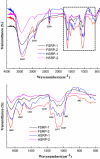Effects of drying on the structural characteristics and antioxidant activities of polysaccharides from Stropharia rugosoannulata
- PMID: 34366479
- PMCID: PMC8292488
- DOI: 10.1007/s13197-021-05120-6
Effects of drying on the structural characteristics and antioxidant activities of polysaccharides from Stropharia rugosoannulata
Abstract
We investigated the structural characteristics and antioxidant activities of two types of neutral polysaccharides and two types of acidic polysaccharides from Stropharia rugosoannulata under different drying methods. Fresh S. rugosoannulata were processed with freeze-vacuum drying (FVD) and hot-air drying (HAD). Polysaccharides from the dried S. rugosoannulata (SRP) were purified using a DEAE-52 cellulose column to obtain two types of neutral SRPs (FSRP-1 and HSRP-1) and two types of acidic SRPs (FSRP-2 and HSRP-2). We found that drying can affect the structural characteristics and antioxidant activities of SRPs. Varied monosaccharide compositions were found in FSRP-1, FSRP-2, HSRP-1 and HSRP-2, and HAD-treated SRP had more glucose and less galactose. The (1 → 6)-α-D-Galp linkage was the primary chain in FSRP-1 and HSRP-1, whereas the (1 → 3)-β-D-Glcp was the backbone structure in FSRP-2 and HSRP-2. Our results thus suggest that hot air drying changed the β-configuration in polysaccharides. FSRP-1, FSRP-2, HSRP-1 and HSRP-2 had positive ferric ion reducing antioxidant power and scavenging activities on ABTS+ and hydroxyl radicals, whereas HSRP exhibited a stronger antioxidant activity than that of FSRP. Hot-air dried S. rugosoannulata could therefore be recommended as a suitable candidate for use in the preparation of antioxidant polysaccharides as functional foods.
Keywords: Antioxidant activity; Characterization; Drying; Polysaccharides; Stropharia rugosoannulata.
© Association of Food Scientists & Technologists (India) 2021.
Conflict of interest statement
Conflicts of InterestThe authors declare no conflict of interest.
Figures





References
-
- Chen G, Li C, Wang S, Mei X, Zhang H, Kan J. Characterization of physicochemical properties and antioxidant activity of polysaccharides from shoot residues of bamboo (Chimonobambusa quadrangularis): effect of drying procedures. Food Chem. 2019;292:281–293. doi: 10.1016/j.foodchem.2019.04.060. - DOI - PubMed
LinkOut - more resources
Full Text Sources
